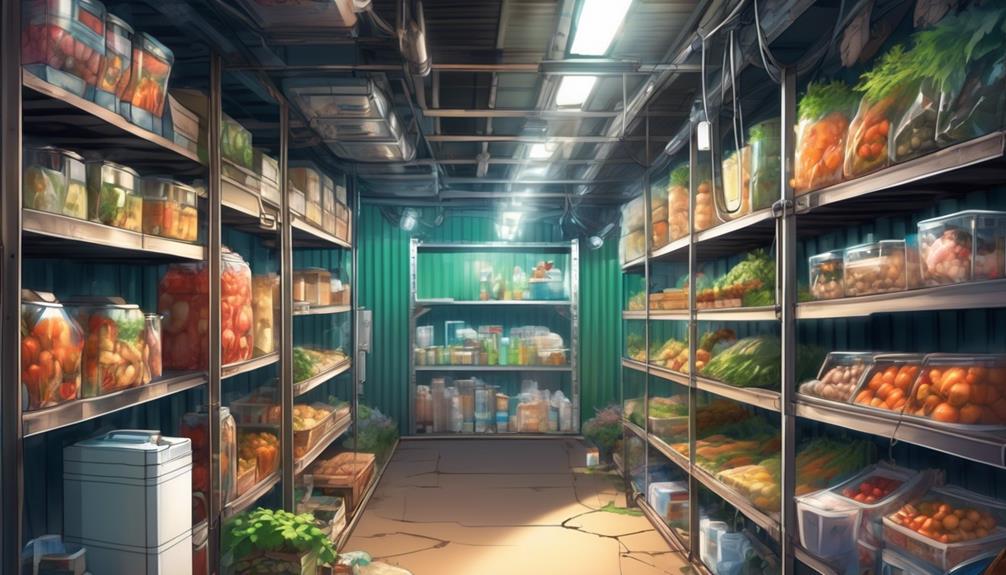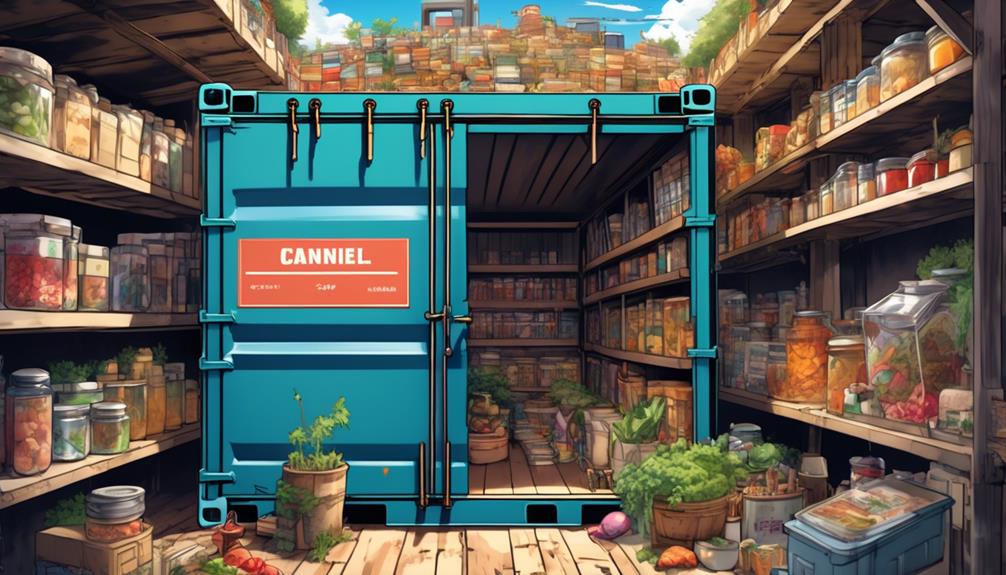Did you know that there are over 17 million shipping containers in the world, with only a fraction of them being used? That means there is a vast potential for repurposing these containers into something useful, like an underground shelter or root cellar.
But why should you consider using a shipping container for these purposes? Well, besides the fact that it offers a durable and secure structure, it can also provide a hidden and protected location for your belongings or family. And that’s just the beginning. There are various benefits and considerations to explore when it comes to utilizing a shipping container in this unique way.
So, let’s dive in and discover the possibilities together.
Using Shipping Containers…
- A shipping container provides a durable and secure structure for an underground shelter / root cellar, offering protection against rust, collapse, and potential emergencies.
- Reinforcing the container with concrete is essential for ensuring stability, preventing collapse, and protecting against rust and leakage.
- Regular maintenance and precautions, such as monitoring the sump pump, installing alarms, and ensuring proper ventilation, are necessary for the upkeep of the underground shelter/root cellar.
- In addition to being used as a root cellar, the shipping container can serve as a wine cellar, emergency shelter, secure storage space, or potential workshop/hobby area.
Benefits of Using a Shipping Container

Using a shipping container underground offers several advantages, one of which is its durability and long-lasting structure. Shipping containers are designed to withstand harsh conditions, making them ideal for underground use. Here are some reasons why their durability is advantageous:
- Structural strength: Shipping containers are built to withstand the rigors of transportation and stacking. Their sturdy construction allows them to withstand heavy loads and resist external pressures. This structural strength makes them suitable for underground applications, where they may be subjected to the weight of the soil and other environmental pressures.
- Protection against rust: Shipping containers are typically made of weathering steel, which is designed to resist corrosion and rust. This resistance to rust is particularly important when using containers underground, where they may be exposed to moisture and a potentially higher risk of corrosion. By using a shipping container underground, you can benefit from its rust-resistant properties, ensuring the longevity of the structure.
- Resistance to collapse: Shipping containers are designed to withstand vertical and horizontal forces, making them resistant to collapse. This is crucial when using them underground, where the weight of the surrounding soil and other loads can exert pressure on the structure. By utilizing a shipping container with suitable reinforcing, you can have confidence in its ability to withstand these forces and provide a safe and secure underground space.
- Cost-effective solution: Shipping containers are readily available and relatively affordable compared to other construction materials. Repurposing a shipping container for underground use can be a cost-effective solution, as it eliminates the need for extensive excavation and construction. Additionally, their long-lasting nature reduces the need for frequent maintenance and replacements, further contributing to cost savings in the long run.
Overall, the durability and long-lasting structure of shipping containers make them an advantageous choice for underground applications. Their ability to withstand harsh conditions, protect against rust, and resist collapse provides a reliable and cost-effective solution for creating underground spaces.
‘Did You Know? Shipping containers were first used for underground shelters during World War II when they were repurposed to protect people from bombings.’
Insulation & Reinforcing With Concrete
Proper insulation is crucial for maintaining a comfortable and controlled environment within the shelter. Insulating the container with materials such as foam board and spray foam helps to regulate temperature and prevent condensation.
Additionally, reinforcing the shipping container with concrete is essential for ensuring its stability and longevity. By incorporating concrete into the structure, you can prevent rust and ensure structural integrity. Here are a few reasons why reinforcing with concrete is crucial:
Preventing rust:
- Concrete acts as a protective barrier, shielding the container from moisture and preventing rust formation.
- Rust can weaken the container’s structure and compromise its ability to withstand external forces
Ensuring structural integrity:
- Concrete reinforcement adds strength to the container, preventing the roof and sides from collapsing under the weight of the soil.
- It provides a solid foundation, increasing the overall stability of the structure.
By properly insulating and reinforcing the shipping container, you can create a secure and well-preserved underground shelter/root cellar for your specific needs.
Considerations for Maintaining the Shelter
To properly maintain your underground shelter/root cellar, regular monitoring and maintenance are essential.
Firstly, it’s crucial to monitor the sump pump to prevent flooding. Regularly check the pump’s functionality and ensure it’s free from any debris or blockages. Install a surface alarm that indicates water levels and raises an alert if there’s a potential overflow. Additionally, consider using a UPS system for the sump pump to ensure continuous operation during power outages.
Secondly, it’s important to prevent moisture buildup in the shelter. Implement proper ventilation to allow for air circulation and reduce humidity levels. Inspect the shelter regularly for any signs of moisture or condensation, as it can lead to mold growth and damage to stored items.
‘Did You Know? Root cellars have been used for centuries to store food and preserve crops, providing a reliable source of fresh produce throughout the year.’
A Shipping Container Being Converted
Given everything just discussed, in the video below you’ll be able to watch as this guy converted his shipping container into a wine cellar. Of course, using the same techniques it could also be used as an emergency shelter or make a very decent root cellar for storing food.
Not a bad little shipping container conversion project right?
Alternative Uses for Shipping Containers

In addition to making a root cellar or underground shelter out of a shipping container, then can also be used for a whole lot of other purposes. Here are a just a few other ideas to consider.
Workshop Space: Transform the container into a workshop where you can pursue your hobbies or work on DIY projects. Create a dedicated space for woodworking, metalworking, or any other activities that require a well-equipped and organized workspace.
Sustainable Farming: Convert the shipping container into a sustainable farming space, such as a hydroponic or aquaponic system. Utilize vertical farming techniques to grow herbs, vegetables, or even small fruits, maximizing your crop yield in limited space.
Pop-up Shop or Retail Space: Set up a temporary or permanent retail space using a shipping container. With some modifications, you can create an attractive and unique storefront for your business.
Art Studio: Turn a shipping container into an art studio, providing a dedicated space for artists to create and showcase their work. The sturdy structure and customizable interior make it an ideal location for various art forms.
Home Office: Create a quiet and separate workspace by converting a shipping container into a home office. It provides a private and distraction-free environment, away from the main living areas.
Café or Restaurant: With proper insulation and ventilation, shipping containers can be transformed into trendy and modern cafés or restaurants. They offer a unique dining experience and can be easily modified to suit your specific culinary needs.
Guest House or Airbnb Rental: Build a comfortable and stylish guest house using shipping containers. They can be designed to accommodate guests and provide all the necessary amenities for a comfortable stay.
Outdoor Storage: Use shipping containers as secure and weather-resistant outdoor storage units. They can be used to store tools, equipment, seasonal items, or even as a garage for vehicles.
Community Center or Classroom: Transform a shipping container into a community center or classroom, providing a versatile space for educational workshops, meetings, or social gatherings.
Emergency Shelters: In times of natural disasters or emergencies, shipping containers can be quickly converted into temporary shelters. They are durable, portable, and can provide basic living conditions for those in need.
Art Installations or Exhibition Spaces: Shipping containers can serve as unique structures for art installations or exhibition spaces. They can be easily transported and arranged to create intriguing and immersive environments for showcasing art.
These are just a few alternative uses for shipping containers. The possibilities are endless, and with some creativity and customization, shipping containers can be repurposed to suit various needs and preferences.
Here are some additional things to consider…
| Alternative Use | Pros | Cons |
|---|---|---|
| Pop-up Shop | – Cost-effective retail space | – Limited size and layout options |
| Office Space | – Quick and easy setup | – Limited natural light |
| Art Studio | – Portable and customizable | – Limited space for larger projects |
| Garden Shed | – Durable and weather-resistant | – Limited ventilation and natural light |
| Swimming Pool | – Easy installation | – Limited size and depth options |
| Café or Restaurant | – Unique and eye-catching design | – Limited space for kitchen equipment |
| Guest House | – Portable and versatile | – Limited insulation and comfort |
| Workshop | – Secure and durable | – Limited space for larger equipment |
| Classroom | – Cost-effective solution for temporary needs | – Limited space for larger groups |
| Gym or Fitness Studio | – Portable and customizable | – Limited space for larger equipment |
It’s important to note that the pros and cons can vary depending on the specific requirements and conditions. These are just general points to consider. Many of the cons can also be addressed with specific modifications and expansions to suit the individual needs.
Overall…
Utilizing a shipping container as an underground shelter or root cellar offers a versatile and secure solution for storing belongings or protecting your family during emergencies. By reinforcing the container with concrete, you ensure its stability and longevity. Proper maintenance practices guarantee the safety and functionality of the shelter. With its durability and hidden location, it’s like having a fortress underground, providing peace of mind like a warm blanket on a cold night.
